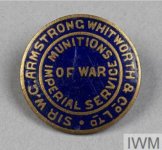Kieran225
Full Member
- Mar 6, 2021
- 190
- 486
- Detector(s) used
- Minelab vanquish 440
- Primary Interest:
- All Treasure Hunting
Follow along with the video below to see how to install our site as a web app on your home screen.
Note: This feature may not be available in some browsers.

Thanks red coat, really happy with that, I always look forward to your responsesNice find on the first one.
It would originally have been enamelled (much of it has deteriorated), and is an “On War Service” badge worn by employees of the Armstrong Whitworth armaments company from their Elswick works at Newcastle during WWI.
View attachment 2016268
[Picture copyright of Imperial War Museum]
These badges were issued by government and private firms from December 1914 onwards to identify that the wearer was engaged in essential war work. The badges served to protect such workers from over-zealous recruiters for the armed forces during the war and undeserved criticism that they might be ‘draft-dodgers’ or conscientious objectors.

Sorry I just realised I didn't post a picture of the front but yes your right it's definitely that badge that you have posted, great stuffSecond one looks to be an Australian Imperial Force “Rising Sun” badge. Australia didn’t have specific metal regimental badges during WWI and all units wore the rising sun badge (approved in 1904 and in use until redesigned in 1949) with unit insignia as separate badges.
I would assume it’s a cap badge, for which there are versions with a slide back and a lugged back with a pin through the lugs. Australian badges aren’t really by thing, but I believe the type of back, the arrangement/length of the sun’s rays, and the nature of the piercing through the badge (as well as the wording of course) all help determine whether they are WWI or WWI. Note that this one from WWI has longer rays and different piercing than yours, but I still think yours may be WWI too:
View attachment 2016274
You need to do some googling for comparisons but at least you know what to look for now. Note also that these badges were made as sweetheart pins too.
It's unbelievable how quick you know what things are, very impressive, I really appreciate it, I hope one day I have your knowledgeThird one is a livery button. Possibly a raven or rook. Lots of possibilities, and you may need to search other birds too:
Google Sites: Sign-in
Access Google Sites with a personal Google account or Google Workspace account (for business use).sites.google.com
Your best bet may be to see if any of the designs throw up surnames that match to prominent families in the Tyneside area.
I think the Livery Button is more Dove like. The other IDs, as per norm are correct.Third one is a livery button. Possibly a raven or rook. Lots of possibilities, and you may need to search other birds too:
Google Sites: Sign-in
Access Google Sites with a personal Google account or Google Workspace account (for business use).sites.google.com
Your best bet may be to see if any of the designs throw up surnames that match to prominent families in the Tyneside area.
NICE ID Red-Coat !!1 Kierann225 NICE FIND ALSONice find on the first one.
It would originally have been enamelled (much of it has deteriorated), and is an “On War Service” badge worn by employees of the Armstrong Whitworth armaments company from their Elswick works at Newcastle during WWI.
View attachment 2016268
[Picture copyright of Imperial War Museum]
These badges were issued by government and private firms from December 1914 onwards to identify that the wearer was engaged in essential war work. The badges served to protect such workers from over-zealous recruiters for the armed forces during the war and undeserved criticism that they might be ‘draft-dodgers’ or conscientious objectors.